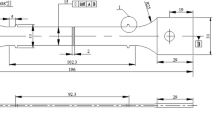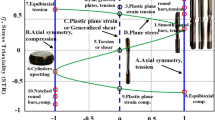Abstract
Creep is one of the important failure mechanisms of structures operating in high-temperature environments, so accurately assessing the creep properties of materials is essential to structural design and analysis. However, most of the creep researches, there is no uniform method to accurately describe the creep deformation and life. On the basis of previous studies, this paper replaceed the nominal stress in the traditional creep model with the normalized stress of tensile strength and obtains a new constitutive model capable of describing the whole process of creep. It is also applied to the evaluation of creep properties of TC11 titanium alloy at 500 °C. The parameters of different creep constitutive models are obtained by fitting experimental data, including 0-projection model, Batsoulas model, CDM model and proposed model. The advantages and disadvantages of different models are also analysed. In addition, the improvement of the new constitutive model is also discussed.
Similar content being viewed by others
Abbreviations
- ai, bi :
-
Material constants of θ-projection model
- A, n* :
-
Norton creep parameters
- A*,B,C*,D,h,H*,kc :
-
Material constants of CDM model
- A’ :
-
Coefficient of Norton equation after stress normalization
- A i :
-
Coefficients of assumed equation for creep performance parameters
- c i :
-
Material constants of proposed model
- C, γ :
-
McVetty creep parameters
- Cmg, λ:
-
Parameters of Monkman-Grant relationship
- H, H(.):
-
Variables for describing the strain hardening effect in the first stage of creep and its rate of CDM model
- k, I, m, n, p, q :
-
Material constants of Batsoulas model
- k1, k2, u, u :
-
Parameters of Wilshire equation
- K,η,α:
-
Variables for temperature and stress of Batsoulas model
- Q, Q* c :
-
Parameters related to material activation energy
- R:
-
Gas constant
- t :
-
Time
- tf tm :
-
Creep rupture life and lifetime at minimum creep rate
- T:
-
Temperature
- β, δ, µ:
-
Variables for temperature and stress of proposed model
- ε c :
-
Creep strain
- εc0, εcm :
-
Initial creep rate and minimum creep rate
- ζ:
-
Material constant related to creep life of proposed model
- Θi :
-
Variables for temperature and stress of θ-projection model
- σ, σ TS :
-
Stress and tensile strength of materials
- Φ, 03A6;̄:
-
Variables describing the coarsening of the carbide precipitates of CDM model and its rate
- ω ω̄:
-
Variables represents the inter-granular creep constrained cavitation damage of CDM model and its rate
- ωf :
-
Critical value of ω
References
F. C. Monkman and N. J. Grant, American society of testing materials, Process, 56 (1956) 593.
F. R. Larson and J. Miller, A time-temperature relationship for rupture and creep stresses, Trans. ASME, 74 (1952) 765–771.
X. Lu, J. Du, Q. Deng and J. Zhuang, Stress rupture properties of GH4169 superalloy, Journal of Materials Research and Technology, 3 (2014) 107–113.
V. H. Dao, J. S. Song, J. Y. Kim and K. B. Yoon, Creep deformation characteristics of microalloyed HP40Nb steel at 950 °C, Journal of Mechanical Science and Technology, 33 (10) (2019) 4813–4821.
V. H. Dao, K. B. Yoon, G. Yang and J. S. Oh, Determination of creep constitutive model for 28-48WCo alloy based on experimental creep tests at 817-982 °C, Journal of Mechanical Science and Technology, 32 (9) (2018) 4201–4208.
B. Wilshire, P. J. Scharning and R. Hurst, A new approach to creep data assessment, Materials Science and Engineering: A, 510–511 (2009) 3–6.
Z. Abdallah, K. Perkins and S. Williams, Advances in the Wilshire extrapolation technique - full creep curve representation for the aerospace alloy titanium 834, Materials Science and Engineering: A, 550 (2012) 176–182.
M. T. Whittaker, W. J. Harrison, R. J. Lancaster and S. Williams, An analysis of modern creep lifing methodologies in the titanium alloy Ti6-4, Materials Science and Engineering: A, 577 (2013) 114–119.
M. T. Whittaker and W. J. Harrison, Evolution of Wlshire equations for creep life prediction, Materials at High Temperatures, 31 (2014) 233–238.
S. P. Jeffs, R. J. Lancaster and T. E. Garcia, Creep lifing methodologies applied to a single crystal superalloy by use of small scale test techniques, Materials Science and Engineering: A, 636 (2015) 529–535.
Z. Abdallah, M. T. Whittaker and M. R. Bache, High temperature creep behaviour in the γ titanium aluminide Ti-45AI2Mn-2Nb, Intermetallics, 38 (2013) 55–62.
M. C. Chaturvedi and Y. Han, Effect of particle size on the creep rate of superalloy Inconel 718, Materials Science and Engineering, 89 (1987) 7–10.
W. Chen and M. C. Chaturvedi, Grain boundary dependent creep behaviour of Inconel 718, Canadian Metallurgical Quarterly, 32 (1993) 363–367.
C. M. Kuo, Y. T. Yang, H. Y. Bor, C. N. Wei and C. C. Tai, Aging effects on the microstructure and creep behavior of Inconel 718 superalloy, Materials Science and Engineering: A, 510–511 (2009) 289–294.
A. C. Yeh, K. W. Lu, C. M. Kuo, H. Y. Bor and C. N. Wei, Effect of serrated grain boundaries on the creep property of Inconel 718 superalloy, Materials Science and Engineering: A, 530 (2011) 525–529.
H. Y. Li, Y. H. Kong, G. S. Chen, L. X. Xie, S. G. Zhu and X. Sheng, Effect of different processing technologies and heat treatments on the microstructure and creep behavior of GH4169 superalloy, Materials Science and Engineering: A, 582 (2013) 368–373.
R. J. DiMelfi, Grain boundary sliding and its relation to ductility and fracture in fine-grained polycrystalline materials with a particular focus on γ -TiAl, Materials Science and Engineering: A, 237 (1997) 141–149.
T. Sugui, L. Zhenrong, Z. Zhonggang, C. Liqing, S. Wenru and L. Xianghua, Influence of deformation level on microstructure and creep behavior of GH4169 alloy, Materials Science and Engineering: A, 550 (2012) 235–242.
A. Chamanfar, L. Sarrat, M. Jahazi, M. Asadi, A. Week and A. K Koul, Microstructural characteristics of forged and heat treated lnconel-718 disks, Materials and Design, 52 (2013) 791–800.
Y. Han and M. C. Chaturvedi, Steady state creep deformation of superalloy Inconel 718, Materials Science and Engineering, 89 (1987) 25–33.
Y. Lee and C. Basaran, A creep model for solder alloys, Journal of Electronic Packaging, 133 (2011) 1696–1699.
Y. K. Kim, D. Kim, H. K. Kim, C. S. Oh and B. J. Lee, An intermediate temperature creep model for Ni-based superalloys, International Journal of Plasticity, 79 (2016) 153–175.
A. M. Othman, D. R. Hayhurst and B. F. Dyson, Skeletal point stresses in circumferentially notched tension bars undergoing tertiary creep modelled with physically based constitutive equations, Proceedings of the Royal Society A - Mathematical Physical and Engineering Sciences, 441 (1993) 343–358.
B. F. Dyson, D. R. Hayhurst and J. Lin, The ridged uniaxial testpiece: Creep and fracture predictions using large-displacement finite-element analyses, Proceedings of the Royal Society A - Mathematical Physical and Engineering Sciences, 452 (1996) 655–676.
R. Mustata and D. R. Hayhurst, Creep constitutive equations for a 0.5 Cr 0.5 Mo 0.25 V ferritic steel in the temperature range 565 °C - 675 °C, International Journal of Pressure Vessels and Piping, 82 (2005) 363–372.
Q. Xu, Development of constitutive equations for creep damage behaviour under multi-axial states of stress, Damage and Fracture Mechanics VI (2000) 435–445.
Q. Xu, Q. Xu, Z. Lu and S. Barrans, A review of creep deformation and rupture mechanisms of Cr-Mo alloy for the development of creep damage constitutive equations under lower stress, Journal of Communication and Computer, 10 (2013) 1219–1228.
N. D. Batsoulas, Mathematical description of the mechanical behaviour of metallic materials under creep conditions, Journal of Materials Science, 32 (1997) 2511–2527.
Q. Meng and Z. Wang, Creep damage models and their applications for crack growth analysis in pipes: A review, Engineering Fracture Mechanics, 205 (2019) 547–576.
A. M. Brown and M. F. Ashby, On the power-law creep equation, Scripta Metallurgica, 14 (12) (1980) 1297–1302.
F. V. Tahami, A. H. Daei-Sorkhabi and F. R. Biglari, Creep constitutive equations for cold-drawn 304L stainless steel, Materials Science and Engineering: A, 527 (2010) 4993–4999.
W.-G. Kim, J.-Y. Park, S.-J. Kim, E.-S. Kim and J. Jang, Improvement of long-term creep life extrapolation using a new master curve for grade 91 steel, Journal of Mechanical Science and Technology, 32 (9) (2018) 4165–4172.
S. G. R. Brown, R. W. Evans and B. Wishire, Creep strain and creep life prediction for the cast nickel-based superalloy IN-I00, Materials Science and Engineering, 84 (1986) 147–156.
Y. N. Rabotnov, Some Problems on the Theory of Creep, National Advisory Committee for Aeronautics, Washington DC, United States, Vestnik Moskovskovo Universiteta, 10 (1948) 81–91.
X. Hu, W. Ye, X. Ma and Y. Song, A new creep damage assessment method for metallic material under variable load conditions at elevated temperature, Fatigue Fracture of Engineering Materials and Structures, 42 (2019) 2725–2737.
Acknowledgments
This work was supported by the National Science and Technology Major Project (2017-IV-0012-0049), China.
Author information
Authors and Affiliations
Corresponding author
Additional information
Recommended by Editor Chongdu Cho
Wenming Ye is currently a Ph.D. candidate at College of Energy and Power Engineering, Nanjing University of Aeronautics and Astronautics, Nanjing, China. He received his B.S. in Aircraft Power Engineering from Nanjing University of Aeronautics and Astronautics, Nanjing, China, in 2014. His research interests include creep property and life prediction in aero-engine materials and structures.
Xuteng Hu is currently a Lecturer at College of Energy and Power Engineering, Nanjing University of Aeronautics and Astronautics, Nanjing, China. His research interests include deformation, fracture and fatigue behavior in metals and aero-engine structures, and foreign object damage in fan/compressor blades.
Yingdong Song is currently a Professor at College of Energy and Power Engineering and State Key Laboratory of Mechanics and Control of Mechanical Structures, Nanjing University of Aeronautics and Astronautics, Nanjing, China. His research interests include strength design, fatigue prediction and reliability analysis of aero-engine structures.
Rights and permissions
About this article
Cite this article
Ye, W., Hu, X. & Song, Y. A new creep model and its application in the evaluation of creep properties of a titanium alloy at 500 °C. J Mech Sci Technol 34, 2317–2326 (2020). https://doi.org/10.1007/s12206-020-0507-7
Received:
Revised:
Accepted:
Published:
Issue Date:
DOI: https://doi.org/10.1007/s12206-020-0507-7




